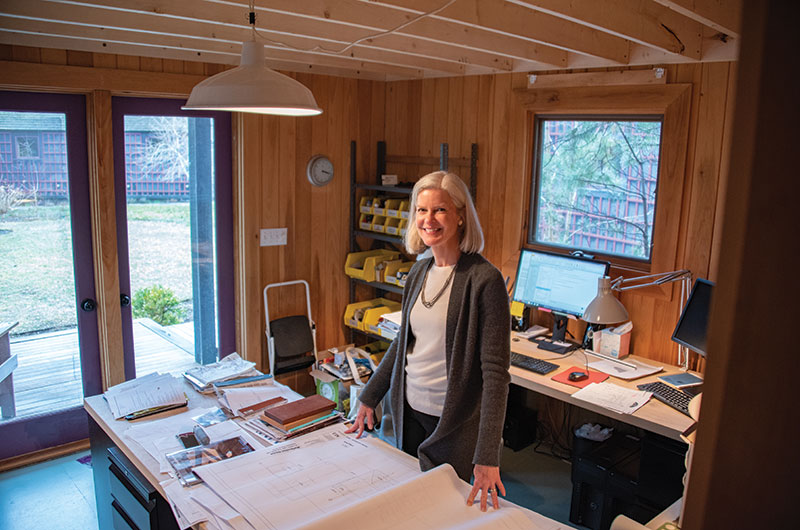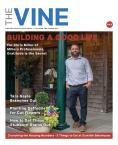Name: Stephanie Mashek
Profession: Architect
Washed ashore from: Cambridge, Mass.
Years ago: 15
Favorite spot on the Island: In a catboat on Nantucket Sound
Favorite room in the house: Her sun-filled dining room
Growing up in the Washington, D.C. area, Stephanie Mashek knew in her early teens that she wanted to be an architect. She must have been prescient, as her career has turned out to suit her perfectly. She thinks before she speaks. Her answers to questions are thoughtful and detailed — just what you would want from an architect — and she’s clearly delighted with the career path she’s chosen.
After studying architecture as an undergraduate at the University of Virginia and going on to get her Masters in Architecture at Harvard University Graduate School of Design, she started her career in the Boston area. When she married Ken MacLean, Jr., a fellow architect, they joined forces professionally. After visiting the Vineyard with friends many times, they began to take on projects here, eventually buying property, building a home, and then moving here year-round. While they’ve done many commercial and residential projects on the Island, two of their most notable have been the Oak Bluffs Public Library and the YMCA.
Q. What led you to become an architect?
A. From my early teens, I was interested in spaces and how they related to each other in different structures, and I just started reading about it. I got books out of the library, and then some friends of my parents gave me books.
Q. How did you end up on Martha’s Vineyard?
A. We would come to visit friends on the Island and that turned into, ‘Gee, we really love this place. What would it take to get a little house or a piece of property here?’ First, we bought a piece of land and we designed what was just going to be a summer camp. But that very quickly turned into, ‘Oh, we’re going to insulate this and put a wood stove in because we want to be here in the shoulder months.’ Then a couple of years later, ‘Why don’t we just live here?’ We added on to that house!
Q. Was it hard to make that decision?
A. Actually, it worked out pretty smoothly. We were working on the new Y at the time. Construction was happening, we needed to be here; and after that was complete, we closed our Boston office and decided to do everything here.
Q. The Y was quite a project!
A. The Y was the most remarkable project we’ve ever done, because we are members and I teach yoga there as well. It is the one project in our lives that we have the most ongoing involvement with. That doesn’t happen a lot. Usually, you just birth these things and that’s it.
Q. Would you make any changes to the Y, now that it is up and running?
A. Oh sure. It was a huge leap of faith for everybody, to do that project. The board had studies done of what the usage might be, but nobody really knew. There were changes made initially to stay within budget. A few things were eliminated, things we knew that we needed. For example, there is no bathroom on the second floor. But the Y at this point is so successful that I’m optimistic that the bathroom—and more—will be added.
Q. In your experience, what makes a successful client-architect relationship, whether in a commercial project or in a home residence?
A. Certainly sharing ideas and thoughts and keeping the lines of communication open.
Q. When is it wise to hire an architect?
A. There really is no set rule. Some people will hire an architect no matter what. Others will work with a builder, add a room, and work out the design as they go. A lot of builders have great eyes.
Q. So what can an architect provide?
A. Taking the time to think through and plan a project is hugely important. You should take the time because you’re investing a lot of money, whether it’s a little addition or a complete house. With an architect, that stage of planning is built into the process.
I spend a lot of time with people trying to work out how they’re going to use their spaces, what they need in them, the way they live, the way they entertain, and the way they have family and friends visiting in summer, and what they need when that happens.
Q. How do we set expectations with an architect? What questions should we ask?
A. If you have not worked with an architect before, you should ask how long the process will take and when you can expect to start building. What are the steps towards that goal? How will this play out? What are the kinds of things we’ll be working through together?
Q. What about during construction?
A. The architect never supervises construction, because that’s the contractor’s job. But an architect can be involved. I like to visit a project once a week at least to answer questions, and to make any changes that come up, because not everything is going to be figured out on paper.
Q. How are fees structured?
A. Architect fees are generated in lots of different ways. In Boston, we used to charge 15% of construction cost for our fee, and that worked out in a balanced way. But the cost of construction is so much higher here that I have found it more beneficial to the client to charge an hourly fee. The largest chunk of the fee, naturally, is for the design phase.
Q. What do you love about what you do?
A. I love working to figure out a nicer home, a better home that is going to work for our clients and bring them joy. I like meeting peoples’ expectations, and I also love creating something that I like.
Q. What do you love about doing it here?
A.There are wonderful craftsmen here, a lot of people who really like figuring things out and who are very good at what they do. And I enjoy getting advice from contractors. After all, they are coming with a different perspective and can often add much to the process. Having a good relationship with a contractor you respect and with talented craftsmen just creates joy all around.
Paula Lyons is a former ABC and CBS television consumer journalist.












Comments